Table Manners in Japan || Learn How To Present Yourself Like The Natives
Japanese Dining Etiquette You Need to Know || Level ★-★★★
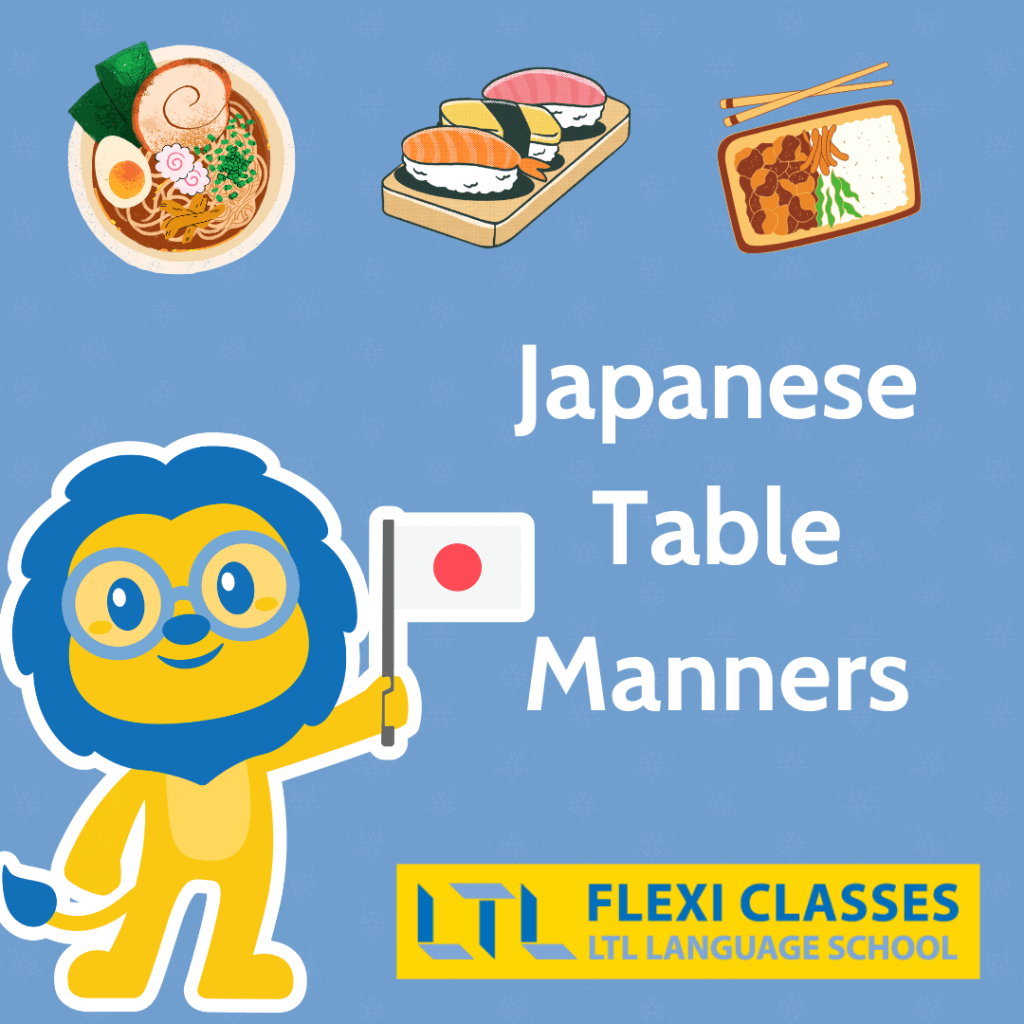
If you love Japanese dishes or love to try them then it might be a good idea to understand Japanese table manners?
Table manners are a very important part of Japanese culture.
It expresses your respect for the people who prepare your meal and the people at your table.
It also expresses your gratitude that you are able to have meals.
Discovering must-eat Japanese food is the first thing you’ll want to do though, so if you haven’t seen it already, check out this article 🤩

Traditional Japanese Food // 10 Of The Very Best (You Have To Try)
Traditional Japanese food is some of the best food this planet has to offer but it’s not all about Sushi. We discover some gems and must eat things in Japan
Japanese Table Manners || Level ★ || Phrases
Japanese Table Manners || Level ★★ || Table Manners
Japanese Table Manners || Level ★★★ || Chopsticks
Japanese Table Manners || FAQs
Japanese Table Manners || Level ★
Let’s begin with learning the three must-know phrases for dining.
いただきます (Itadaki masu)
Before you start eating, you will say いただきます (Itadaki masu).
ごちそうさまでした (Gochisou sama deshita)
After you finish the meal, you will say ごちそうさまでした (Gochisou sama deshita).
What meanings are behind these phrases?
いただきます is said to thank all the people who prepare the meal for you, who produced the ingredients, and the fact you are able to have the meal.
ごちそうさまでした is used to show your gratitude for the ingredients.
Since having a meal is also an act of receiving the lives of other living creatures, such as fish and meat, it is also a way of expressing gratitude to them.
In the same way, we think that vegetables also have lives, and we are grateful for the fact that other lives are transformed into energy for our own survival.
Saying these phrases are important to show that you are thankful and not taking for granted to have the meal.
乾杯 かんぱい (Kampai)
If you like drinking alcohol, you need to remember かんぱい !
It is a Japanese drinking salute, so it has the same meaning as “Cheers!” in English.
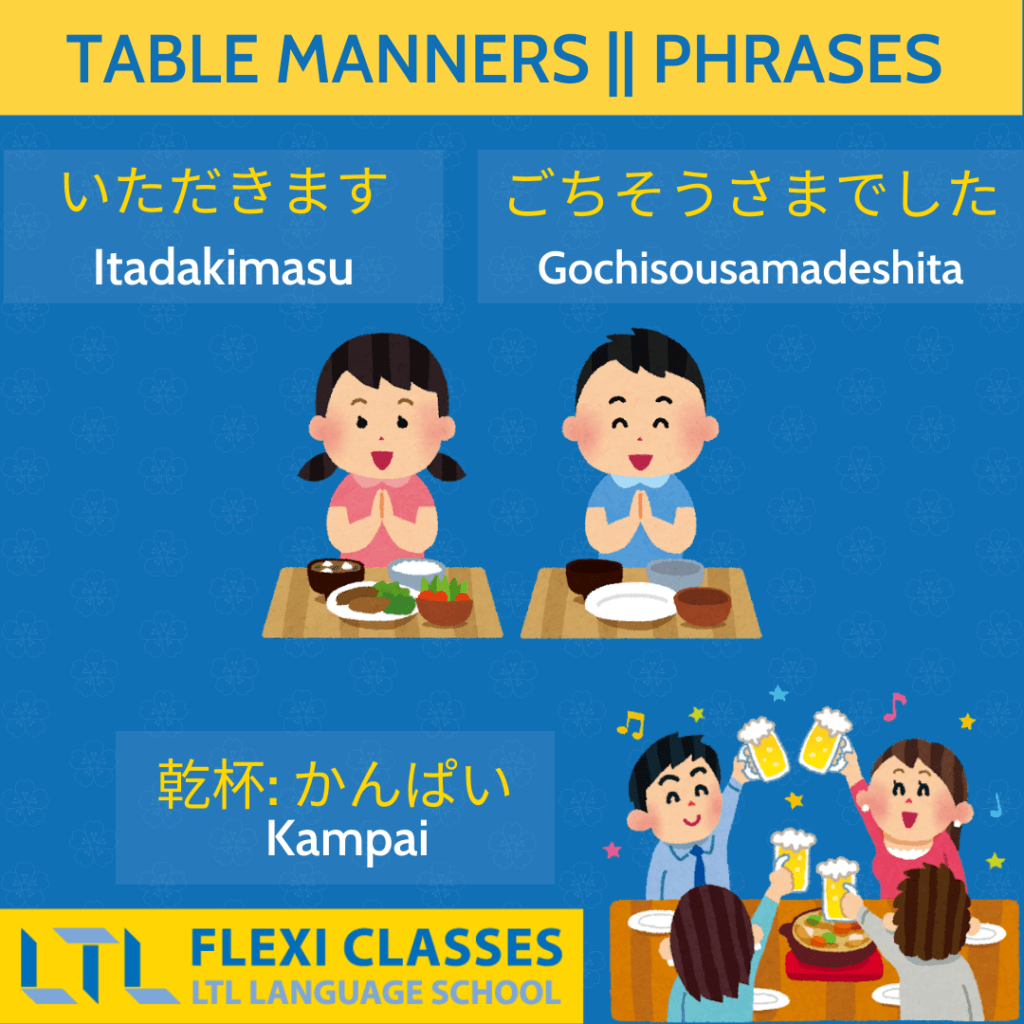
Japanese Table Manners || Level ★★
Now we know the essentials, let’s start taking a look at the Japanese actual manners!
Wet towels are used to wipe your hands only.
When you enter a restaurant, you will get wet towels most of the time.
This is called おしぼり (oshibori) in Japanese, and it is to clean your hands and should not be used for any other purpose.
It shouldn’t be used to wipe your face or the table. Once you finish using it, fold it with the used part inside and put it back in place.
While you are eating, try to maintain your good posture.
I understand that you would feel like you are going to melt after being overwhelmed by how delicious Japanese food is, but keep sitting up straight without leaning on a chair, from the moment you say いただきます until you say ごちそうさま
Don’t put your elbows on the table.
Putting your elbow on the table is considered a rude gesture while you are having a meal.
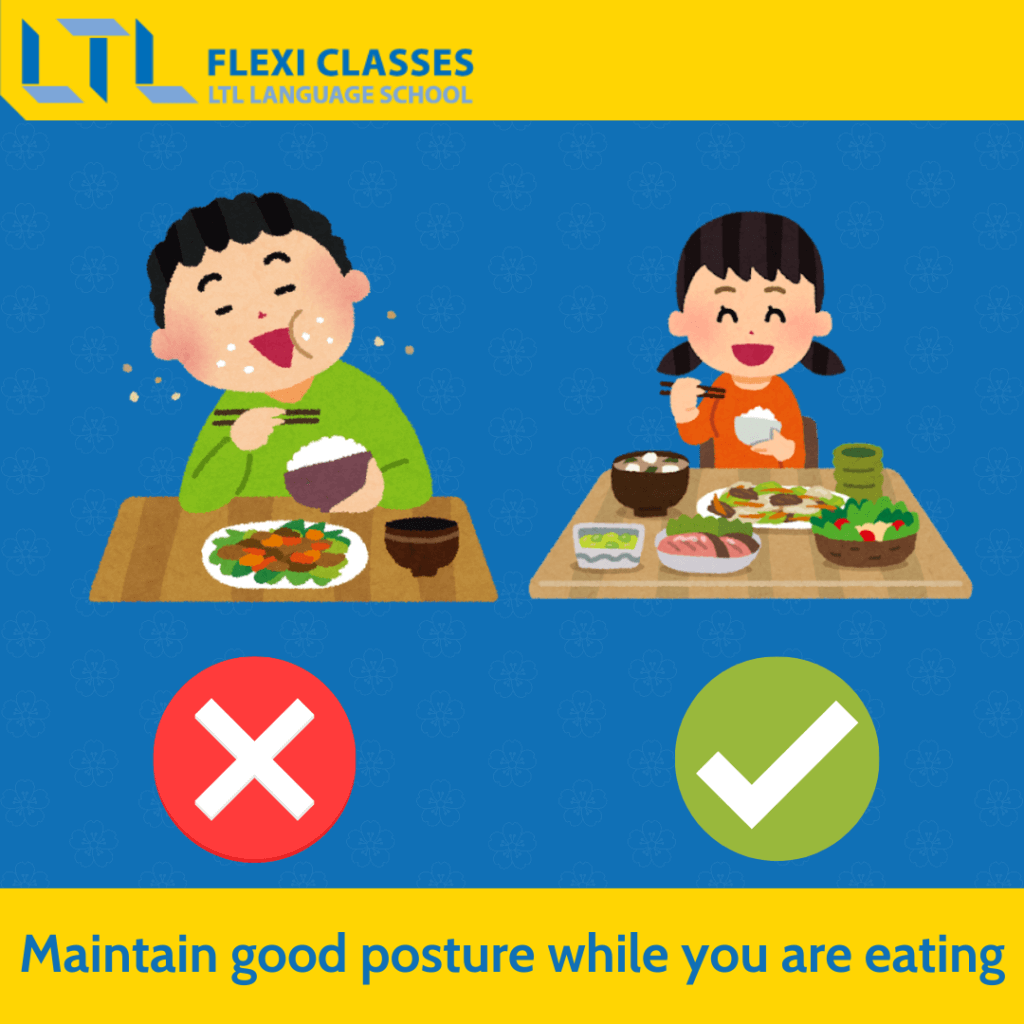
Avoid 犬食い (Inu gui)
The translation to Inugui is “eating like a dog.”
As the dog does not hold the bowl in its hand at mealtime but rather bends forward, bringing your mouth to the dish is an extremely bad posture.
When you are drinking soup or eating noodles, you can bring the bowl close to your mouth.
Keep your left hand on the table.
Keeping the left hand out of the table has been considered “concealing a weapon” in ancient times and still remains a bad manner today.

Place your left hand lightly on the plate or bowl you are eating.
Don’t use your hand like a saucer.
This is called 手皿 (tezara) in Japanese.
For example, when you dip sushi in soy sauce, you might try to use your other hand as a saucer to avoid the sauce dripping on your clothes.
Since this may seem elegant, some Japanese do this too. But it is actually bad manners.
If food spills onto the palm of your hand, it is considered bad manners because it makes your hand dirty.
Use a small plate as a saucer, or if you do not have one, take the dish in your hand and bring it to your mouth to eat.
Be careful with chewing sounds.
Chewing sounds make the people around you will feel uncomfortable.
A person who eats while making chewing sounds is called a “ クチャラー (kuchara)” in Japanese.
This is commonly listed as a turn-off when dating someone in Japan, and it is not that rare that this can be the only reason you may miss the chance for the second date…

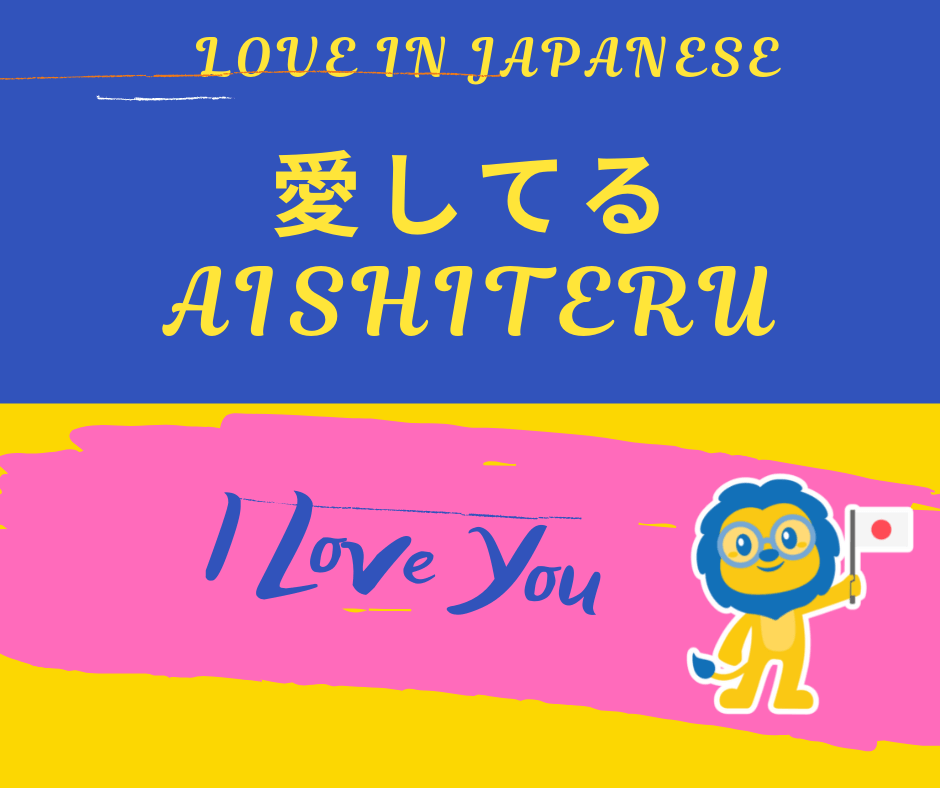
Don’t leave food on the plate/bowl.
Leaving food on the plate is considered rude in Japan. Typically, we are taught to eat every last grain of rice since childhood.
There are even superstitions that say “米粒を残すと目がつぶれる” which means if you leave a grain of rice, your eyes will be crushed and “米粒には神様が7人の神様が宿っている” which means there are seven gods on one single grain.
As these superstitions suggest, leaving food is a big taboo in Japan.

Dating in Japan 💘 Everything You Need to Know
Want to know what it’s like dating in Japan? Japanese dating is a very different experience to that of the west so it’s important to follow certain rules.
These Japanese table manners should be followed at bare minimum. Are you ready to learn more advanced table manners?
Japanese Table Manners || Level ★★★
Did you know there are around 40 different taboos about using chopsticks?
The taboos of chopsticks are called 嫌い箸 (kiraibashi) in Japanese.
Let’s take a look at some of 嫌い箸 with a quick explanation of the correct way to hold the chopsticks.
Chopsticks are called 箸 (hashi) in Japanese. The counter for chopsticks is 膳 (zen), and we count two pairs of chopsticks as one set. A pair of chopsticks is 一膳 (ichi zen).
It is common to see disposable chopsticks made with wood, especially in fast food chain restaurants.
This type of chopsticks is called 割り箸 (waribashi).
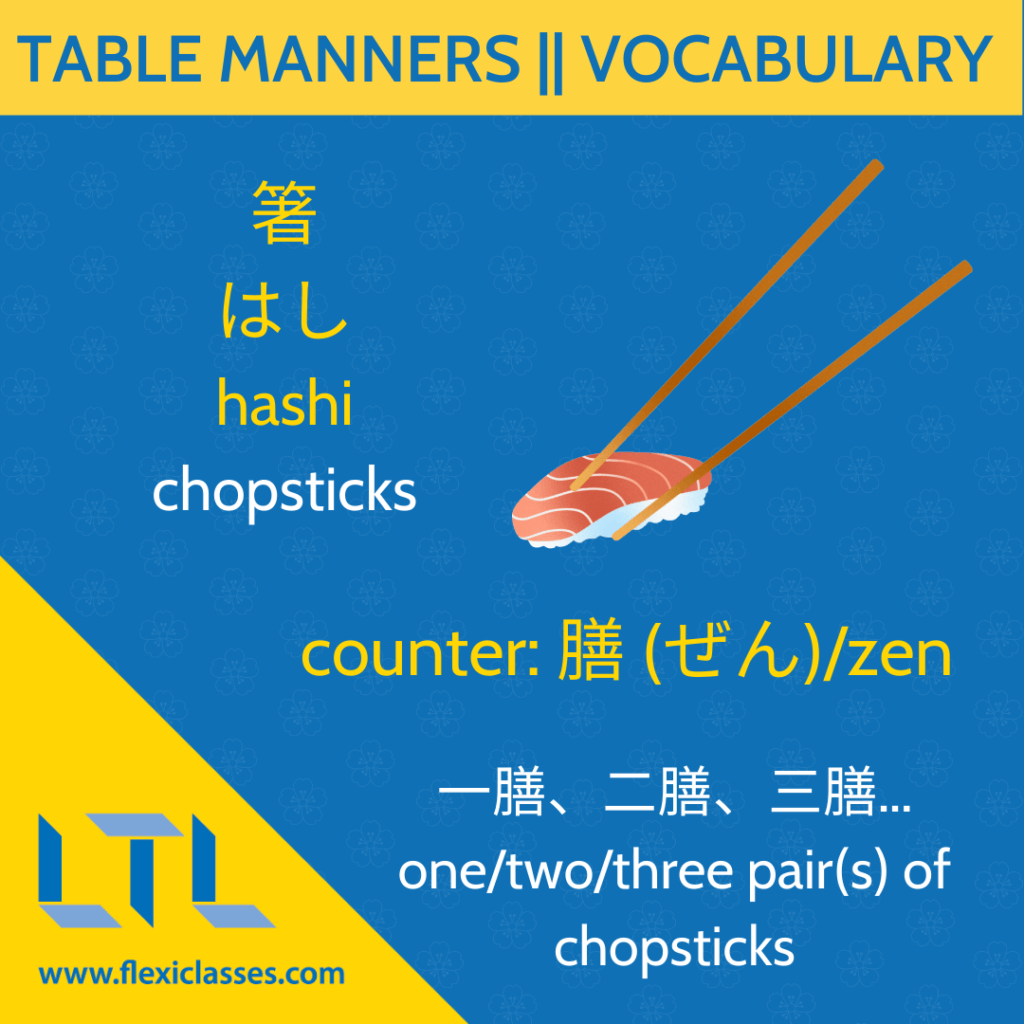
How to Correctly Hold Chopsticks
Even though some Japanese people hold chopsticks incorrectly, it can be difficult when you already have used them in your own way.
Here, let’s practice the correct way together!
- Hold the upper chopstick with your thumb, index finger, and middle finger, like you hold a pencil.
- Now, place the lower chopstick by the base of the thumb and index finger, so it is attached it to the side of the ring fingernail.
- If your middle finger touches to both chopsticks, you are holding them right
- Check if the chopsticks make a straight line when you close the tips of them.
- Keep the lower chopstick in the same place while you are eating.
And that’s it!

Now you can try this with your own chopsticks! If you don’t have any, you can try it with two pens.
嫌い箸 (kiraibashi) Don’ts When Using Chopsticks
Next, let’s learn some of 嫌い箸 that you need to avoid.
刺し箸 (sashibashi)
Don’t stick the chopsticks into food as you do with forks.
Some foods might be difficult to lift up with chopsticks, but avoid this by cutting your food into small pieces.
ねぶり箸 (neburibashi)
Don’t lick your chopsticks to wipe the dirt or food off on the tips of them.
箸渡し (hashiwatashi)

Don’t pass your food from your chopsticks to another person’s ones.
Since this is an act when collecting bones after the cremation (in the Buddhist funeral), 箸渡し is one of the most serious taboos.
立て箸 (tatebashi)
Don’t stick the chopsticks straight up into the rice.
In the Buddhist manner, placing a bowl of rice with sticking chopsticks at the bedside of the dead person. So this is considered bad same as 箸渡し.
迷い箸 (mayoibashi)
Don’t hover your chopsticks over the dishes when deciding which one to eat next.
涙箸 (namidabashi)
Don’t lift up your chopsticks when soup or sauce drips from the food.
Gently press the food against inside the bowl before you bring the food to your mouth.
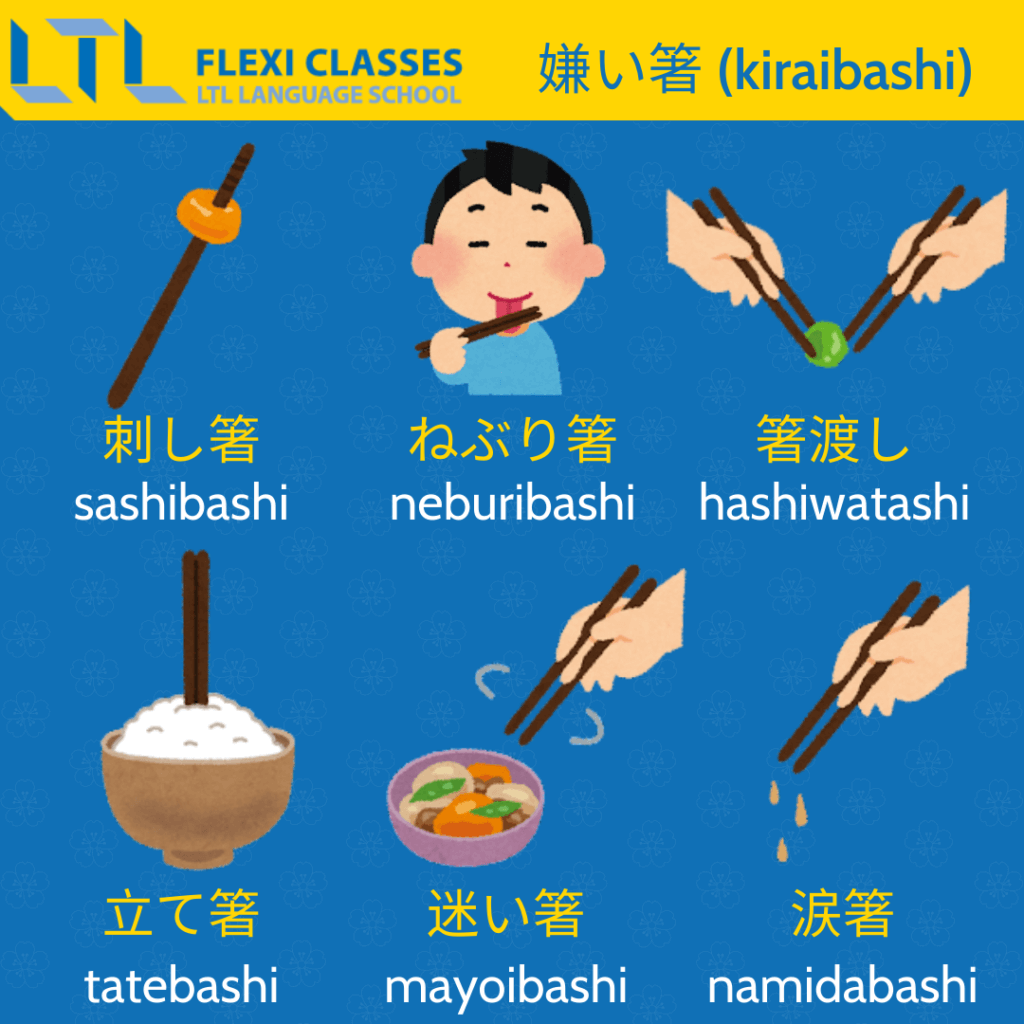
And there you have it. A complete level-up guide to Japanese table manners and dining etiquette in Japan.
Remember these table manners and you’ll enjoy Japanese cuisine more than before 😍
Do you want to know Japanese etiquette besides for dining? Check out this post and get more familiar with Japanese etiquette!
BONUS || We also wrote a similar post on dining etiquette in China. See how it compares with Japan.
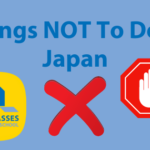
Things Not to Do in Japan 🙅♀️ Guide to Japanese Etiquette
Things Not to Do in Japan 🇯🇵 The ULTIMATE list of DON’Ts for your time in Japan and how to maintain perfect Japanese Etiquette
Japanese Table Manners || FAQs
What are some must-know phrases for dining in Japan?
Say いただきます (Itadakimasu) before you start eating and ごちそうさまでした (gochisousamadeshita) after you finish the meal.
乾杯 (kampai) is a Japanese version of “Cheers!”
What should I do if I am full and can’t finish the meal but don’t want to be rude?
If the meal is great, say ごちそうさまでした, and that you liked the meal.
You can say 美味しかったです (Oishikattadesu: The meal was great.)
What is 嫌い箸 (kiraibashi)?
嫌い箸 is taboo for using chopsticks.
There are around 40 of them in total!
This sounds like too many, but as long as you remember some of serious taboos, you can relax and enjoy your meal:)
What is it called when I stick my chopsticks in rice?
Firstly don’t do this! It’s considered very rude in Japanese culture.
It is one of the chopstick taboos in Japan and is called 立て箸 (tatebashi).
Want More From LTL?
WANT TO LEARN JAPANESE? Check out our online Japanese courses here.
We offer a 7-day free trial to all new students where you can study 24/7.
What about studying Japanese in Japan instead? We’ve got your back. Our Japanese courses in Tokyo can either be taken in small groups of no more than 5 students or individually for a more tailored experience.
We even offer incredible homestay experiences in Tokyo as well.
Come and be a part of this amazing community.








